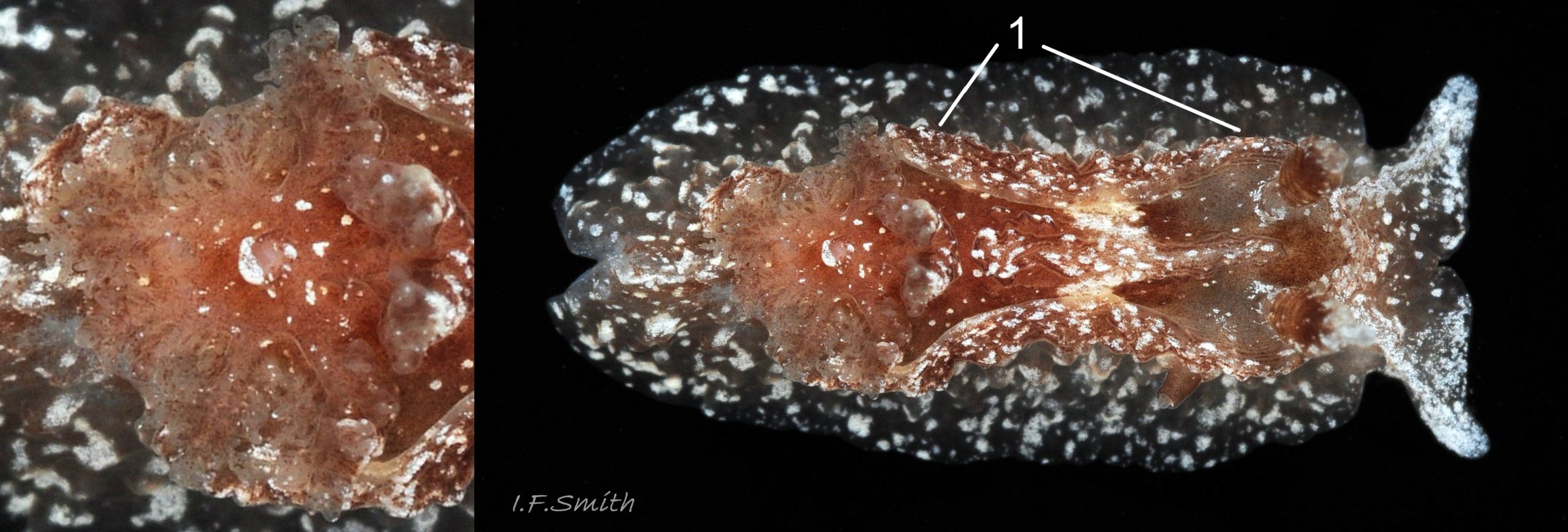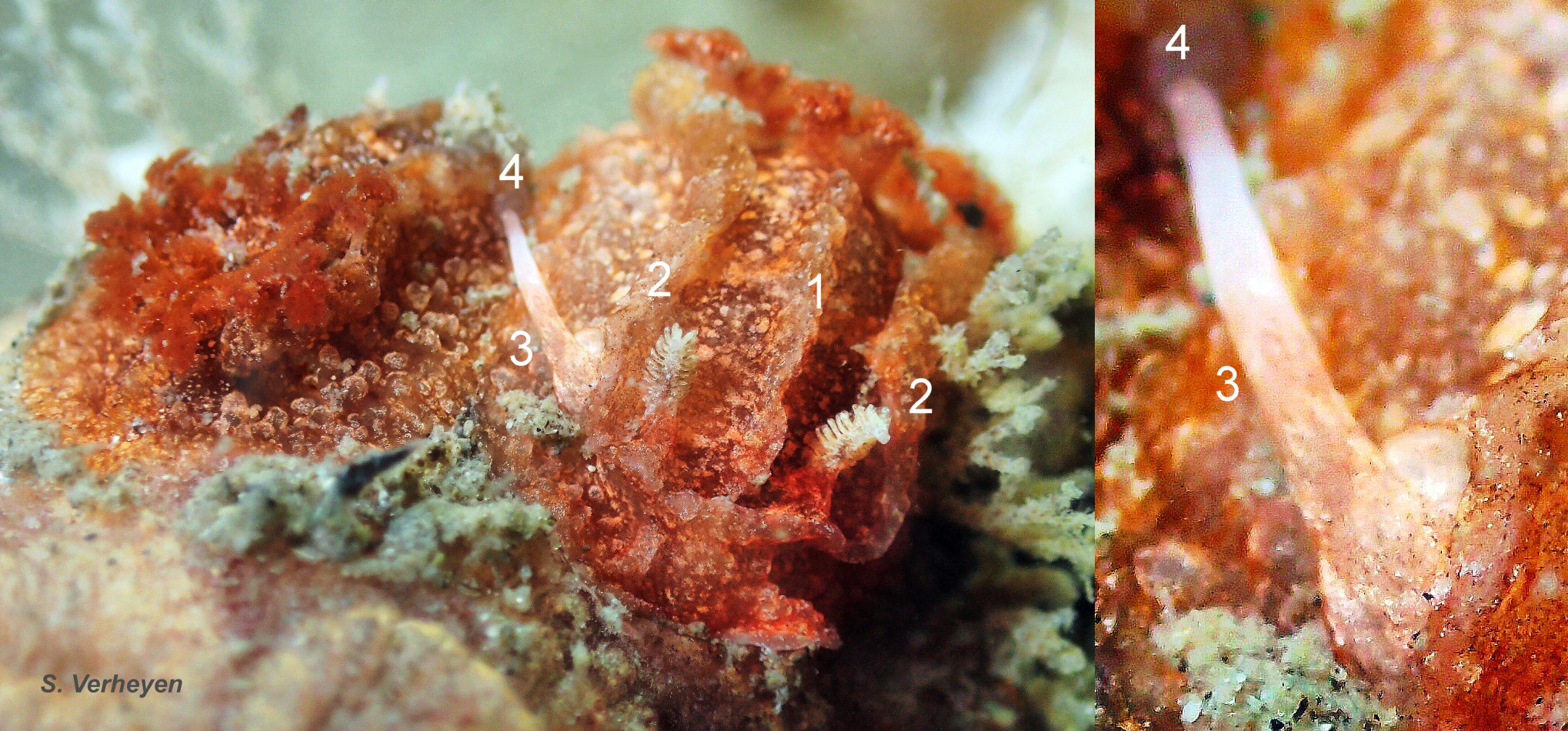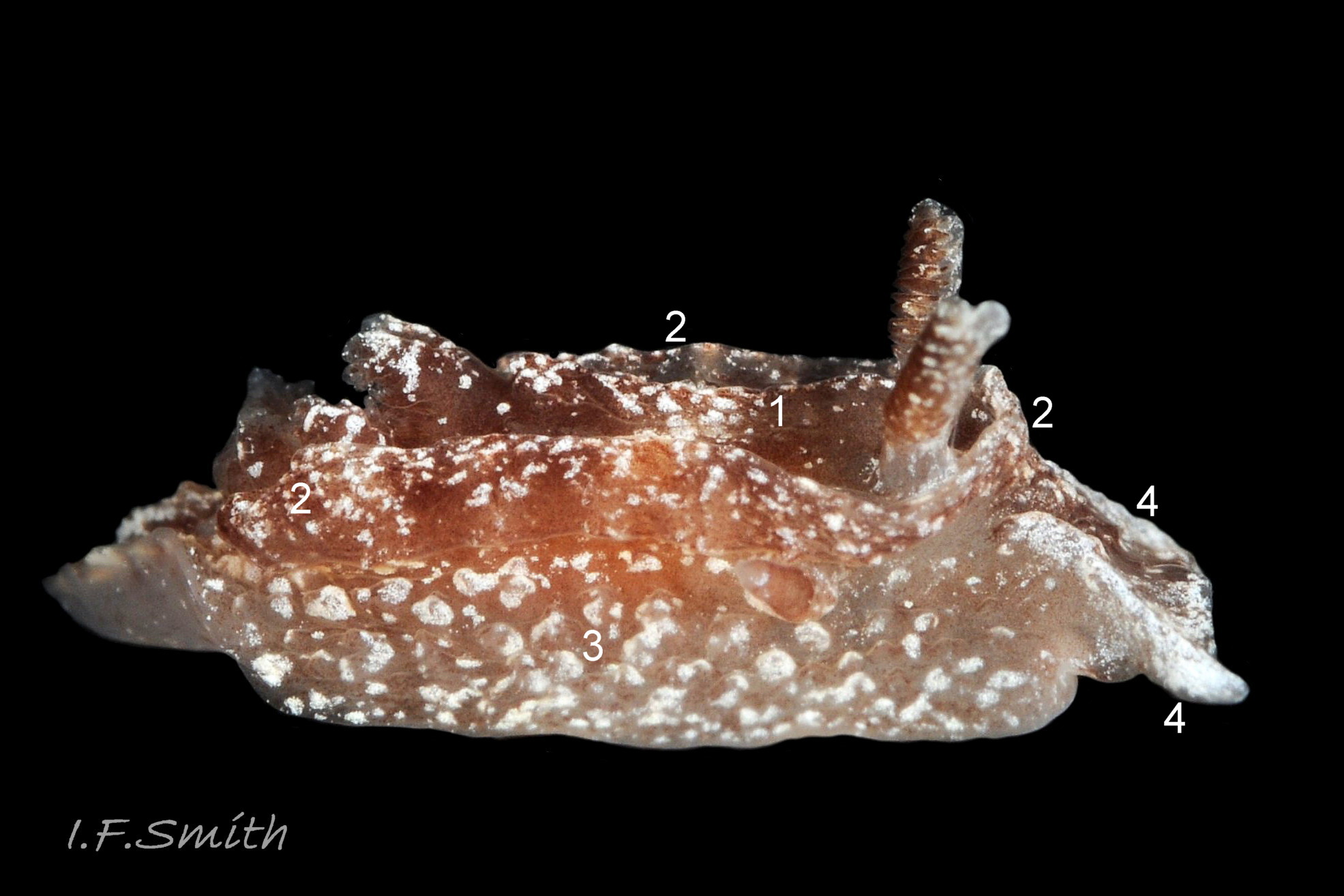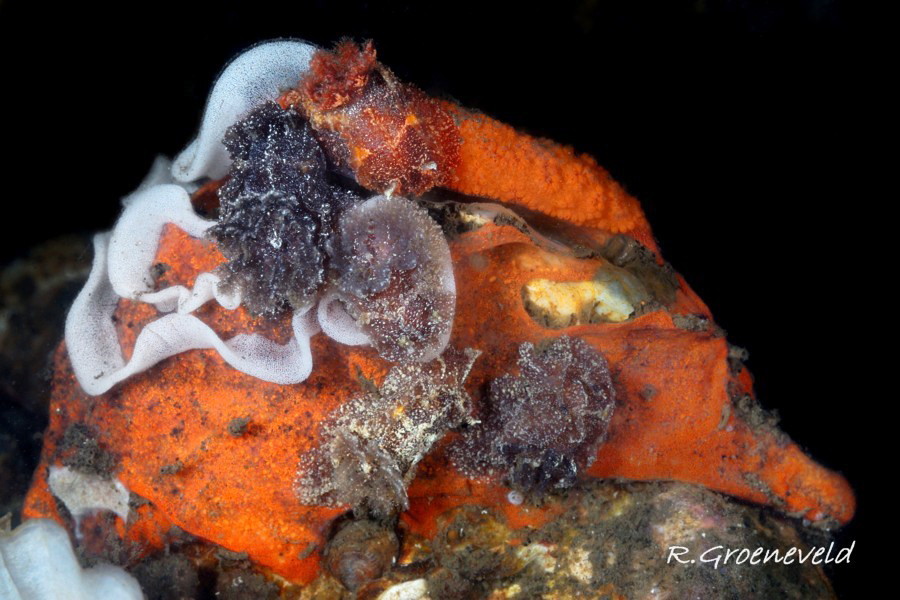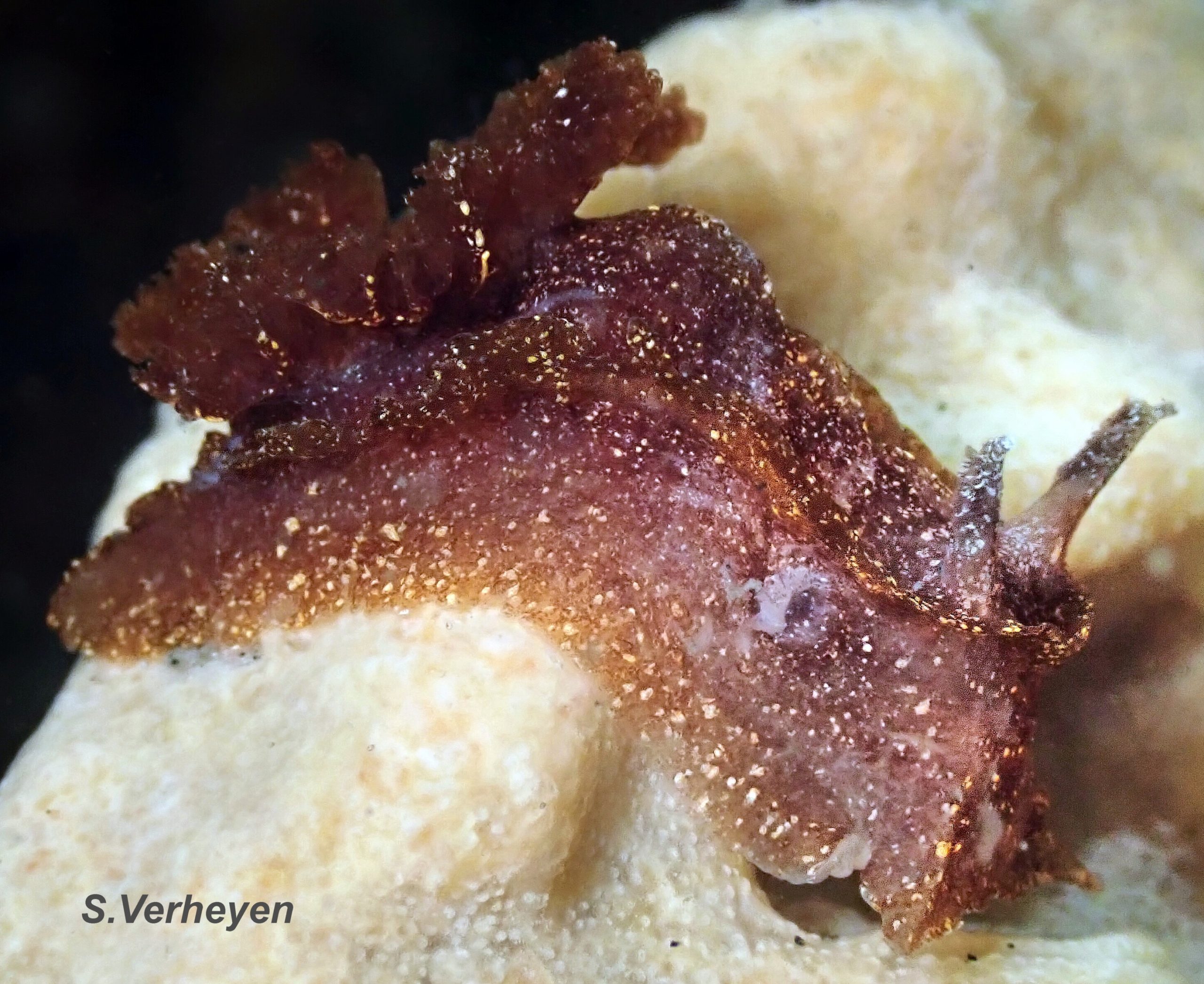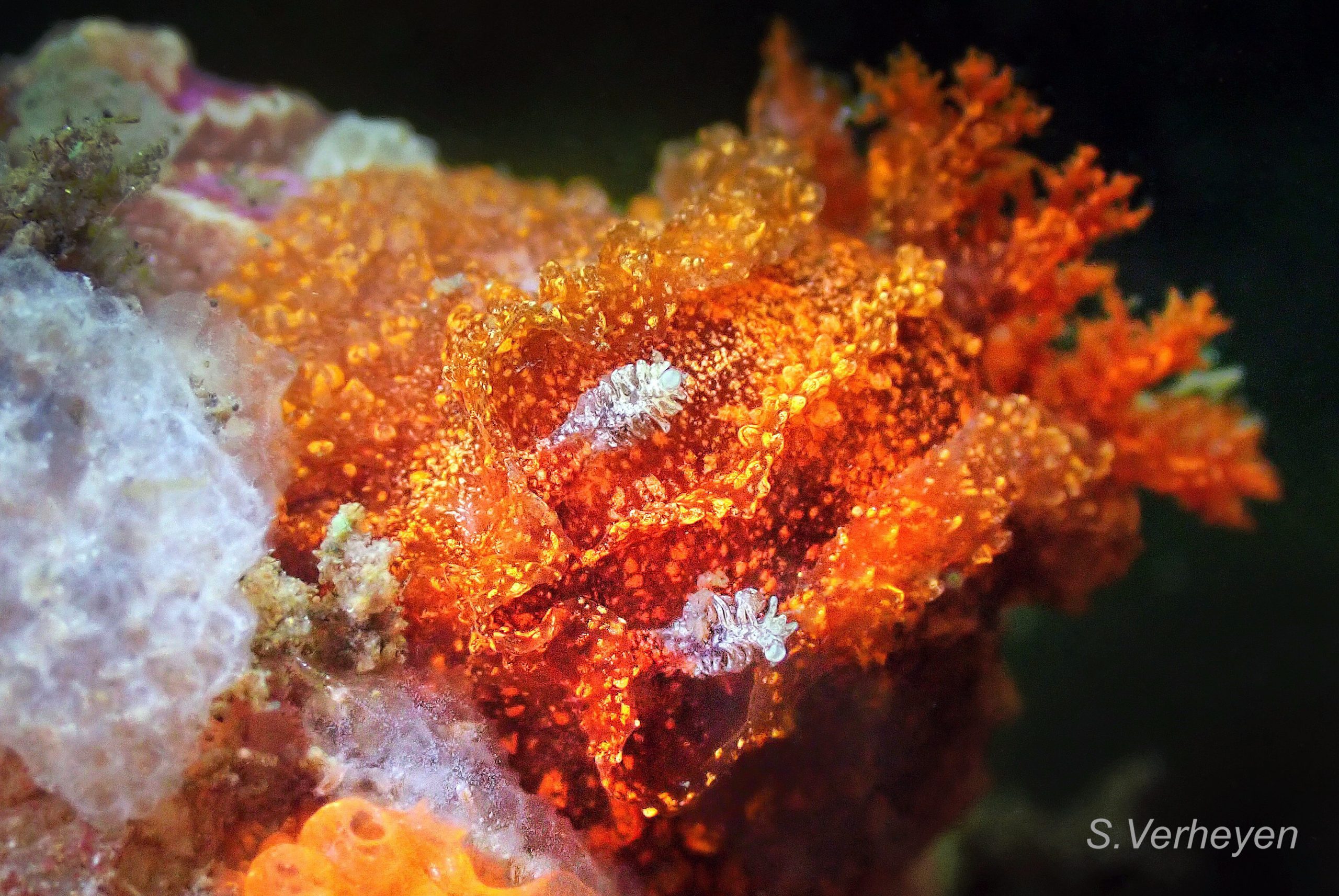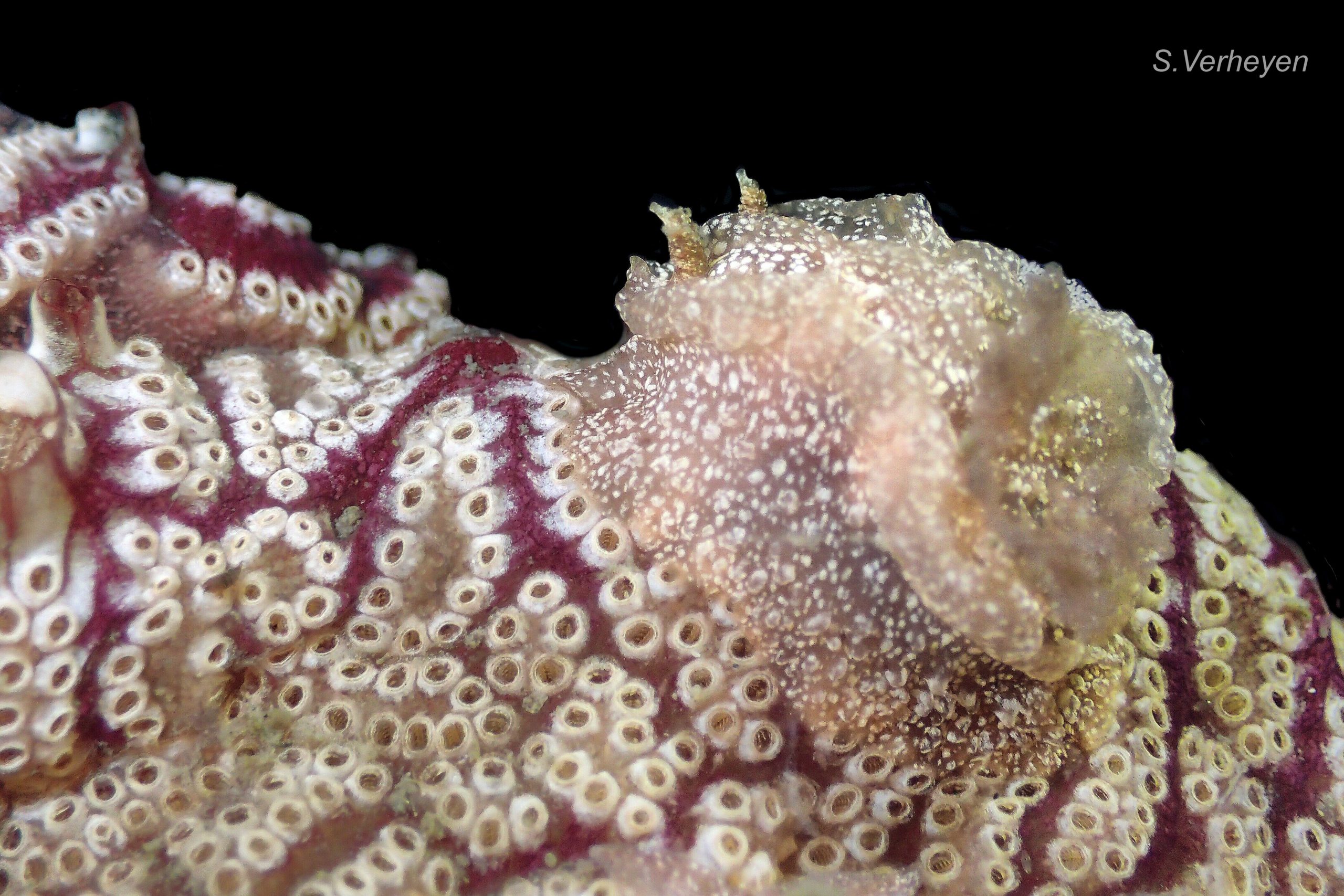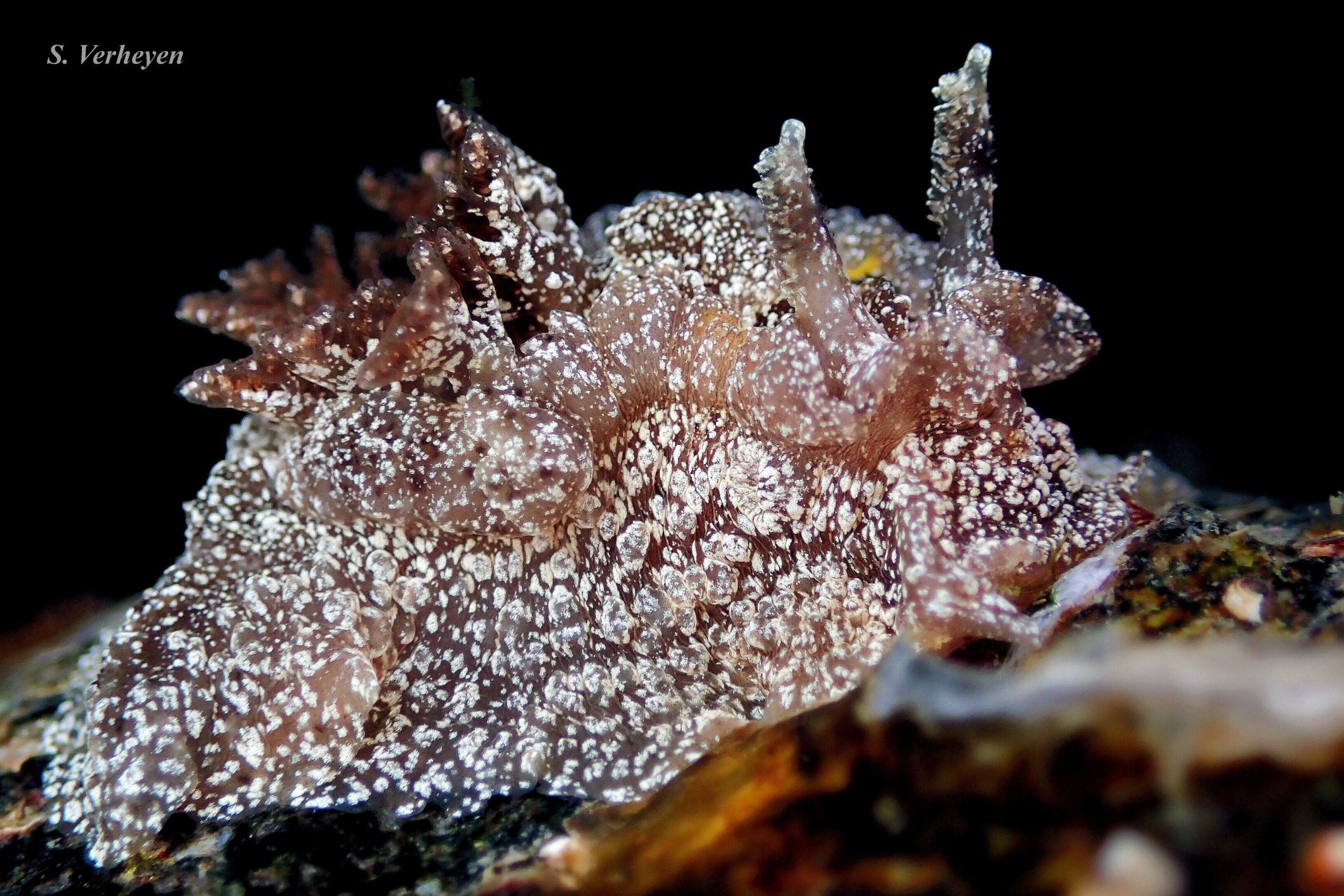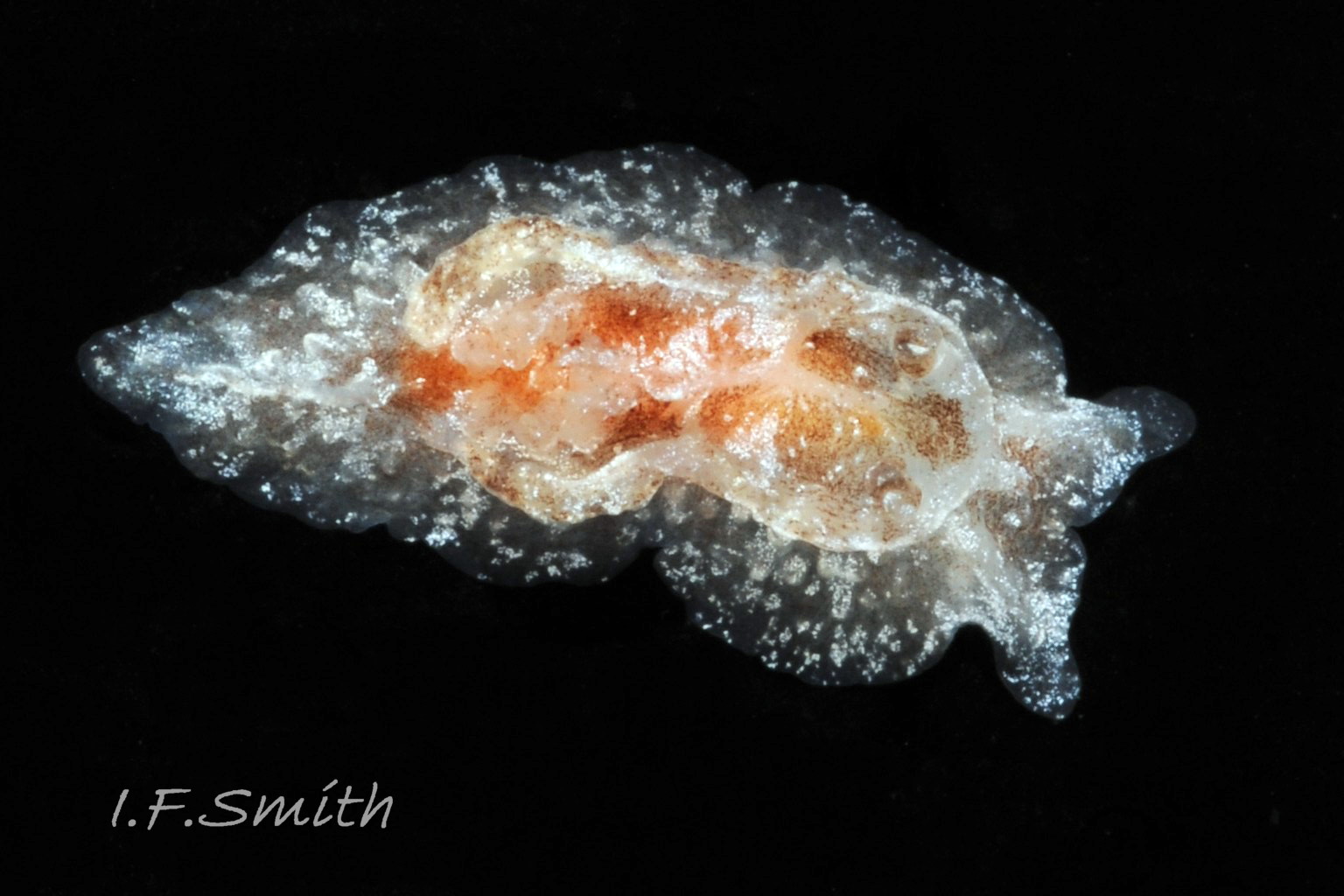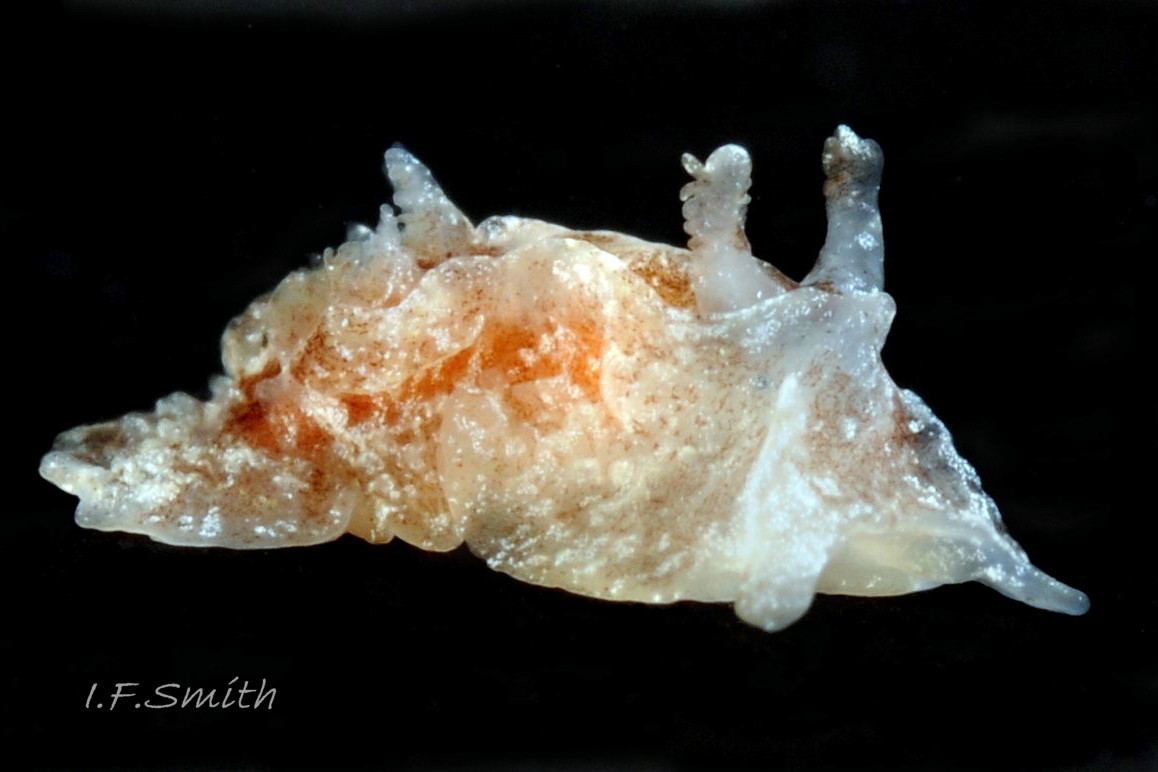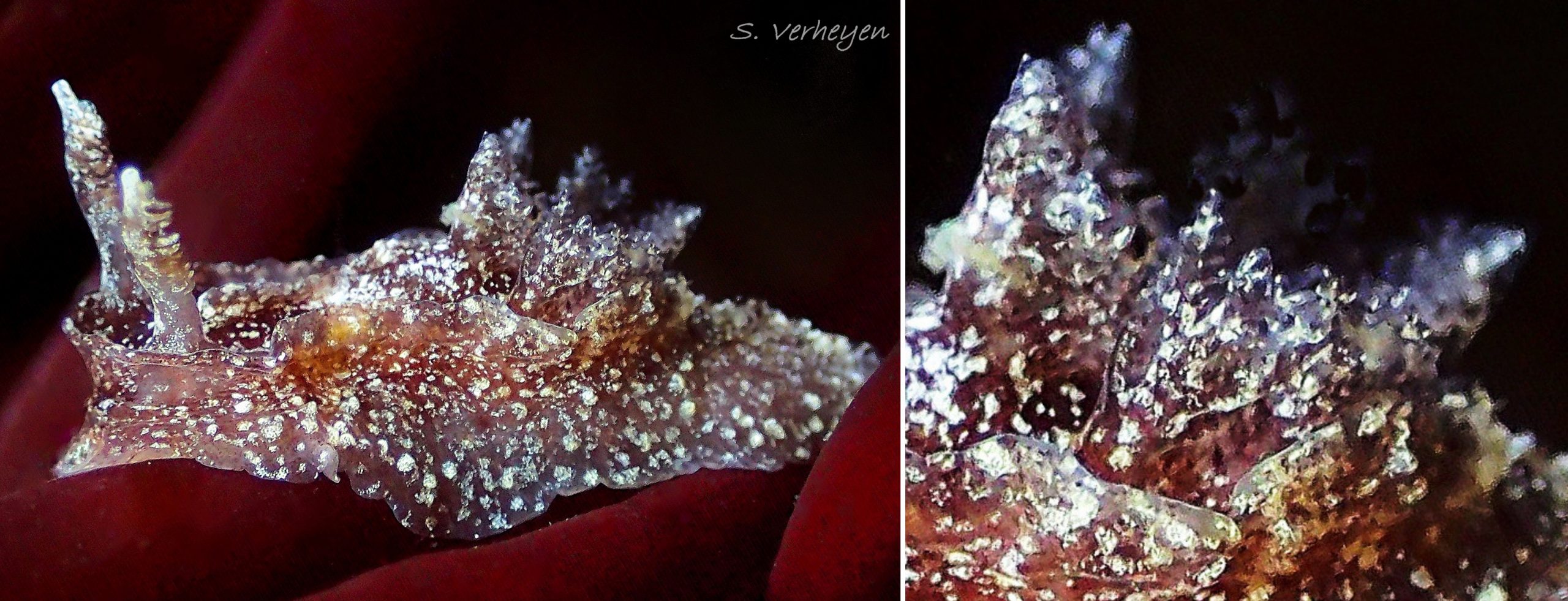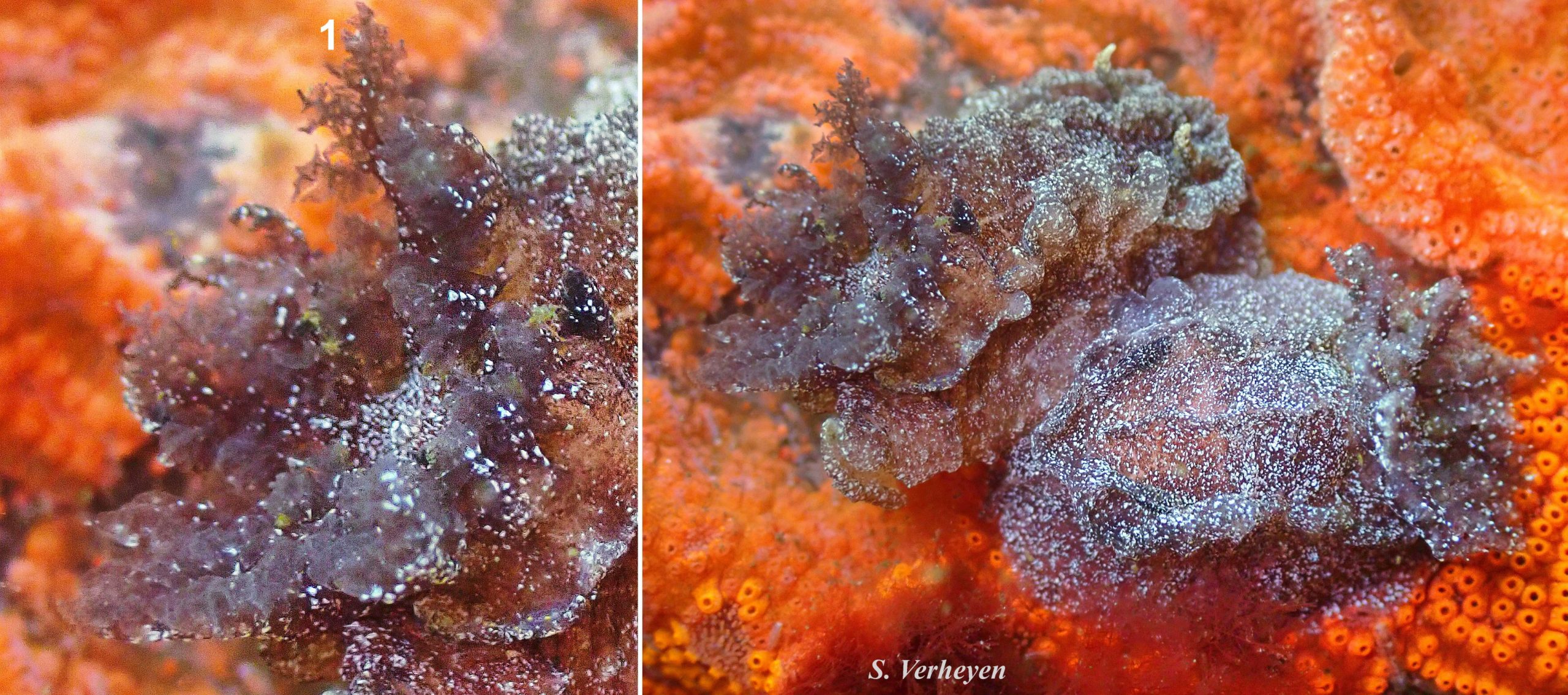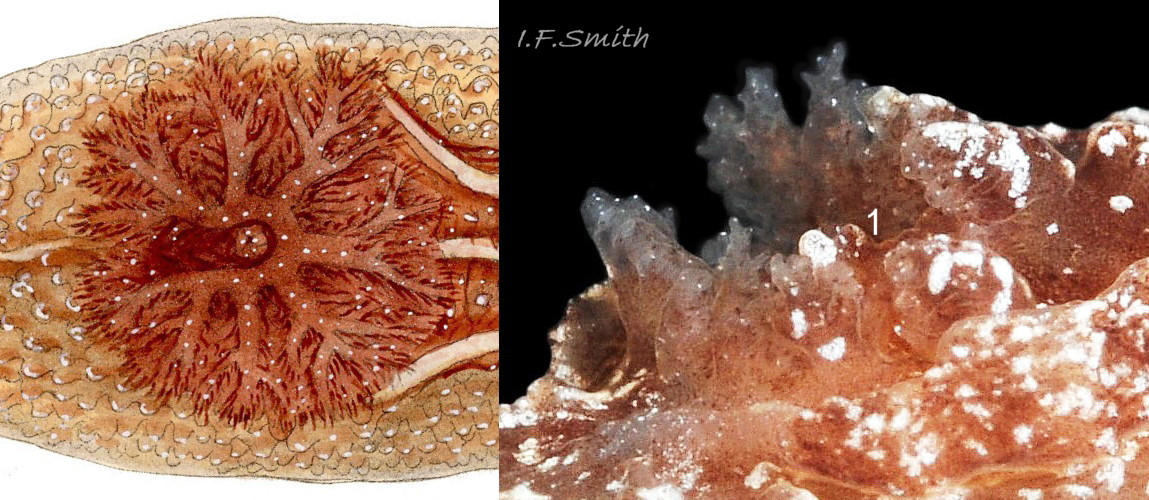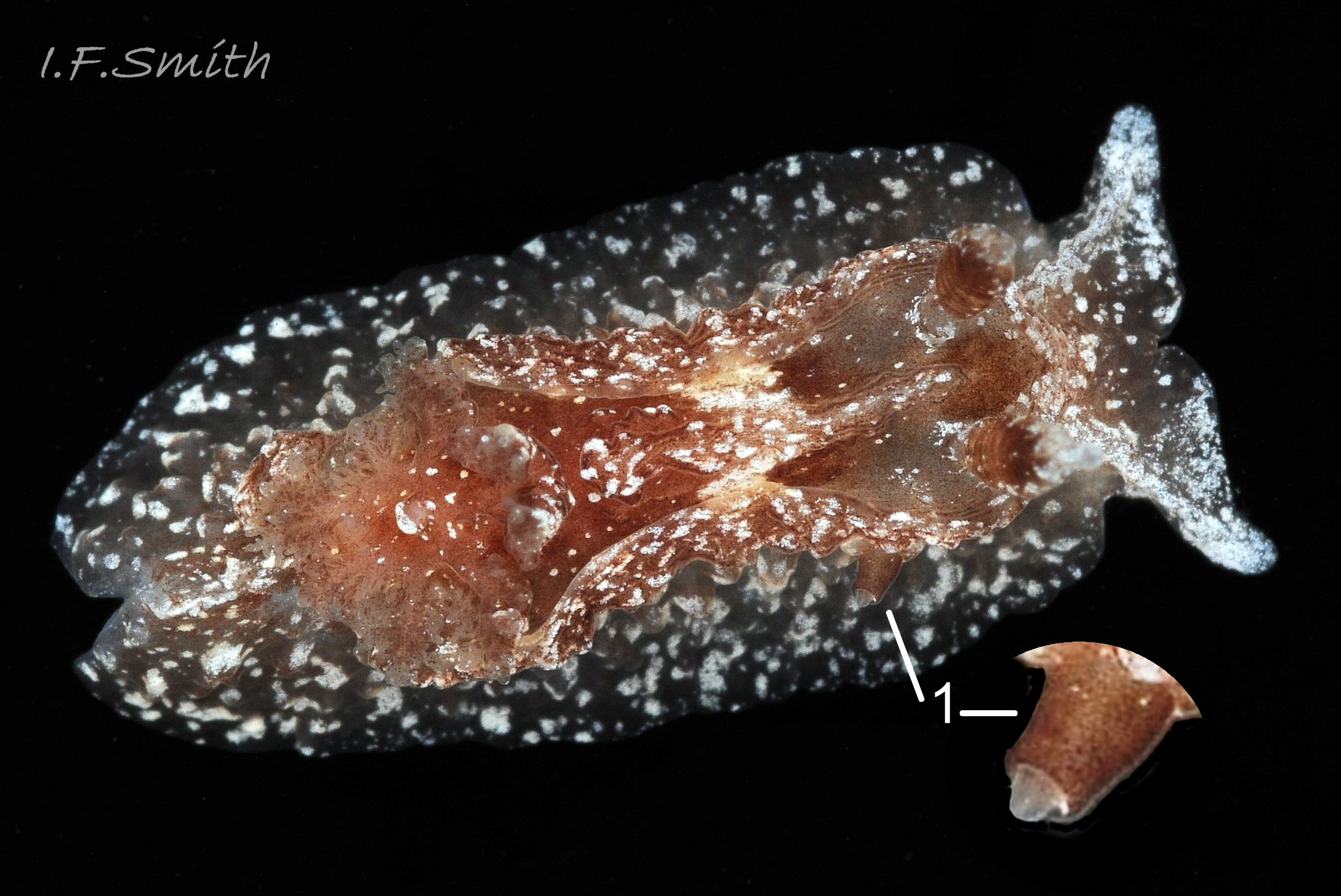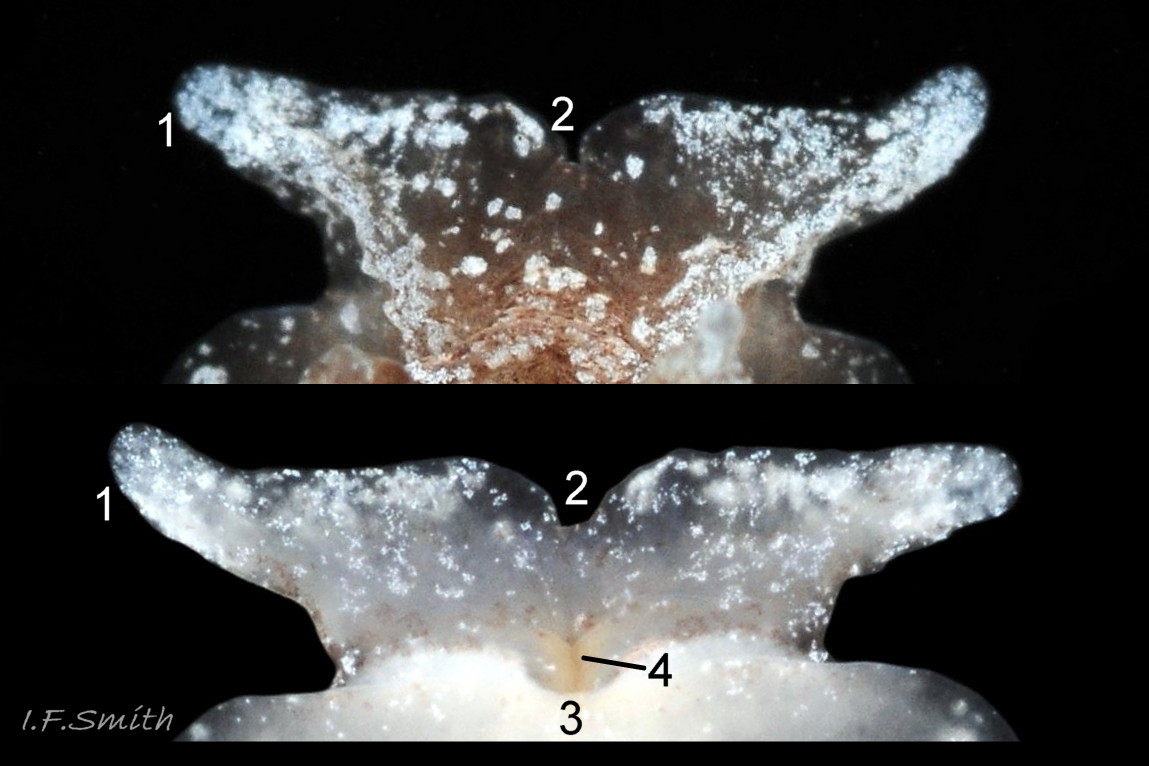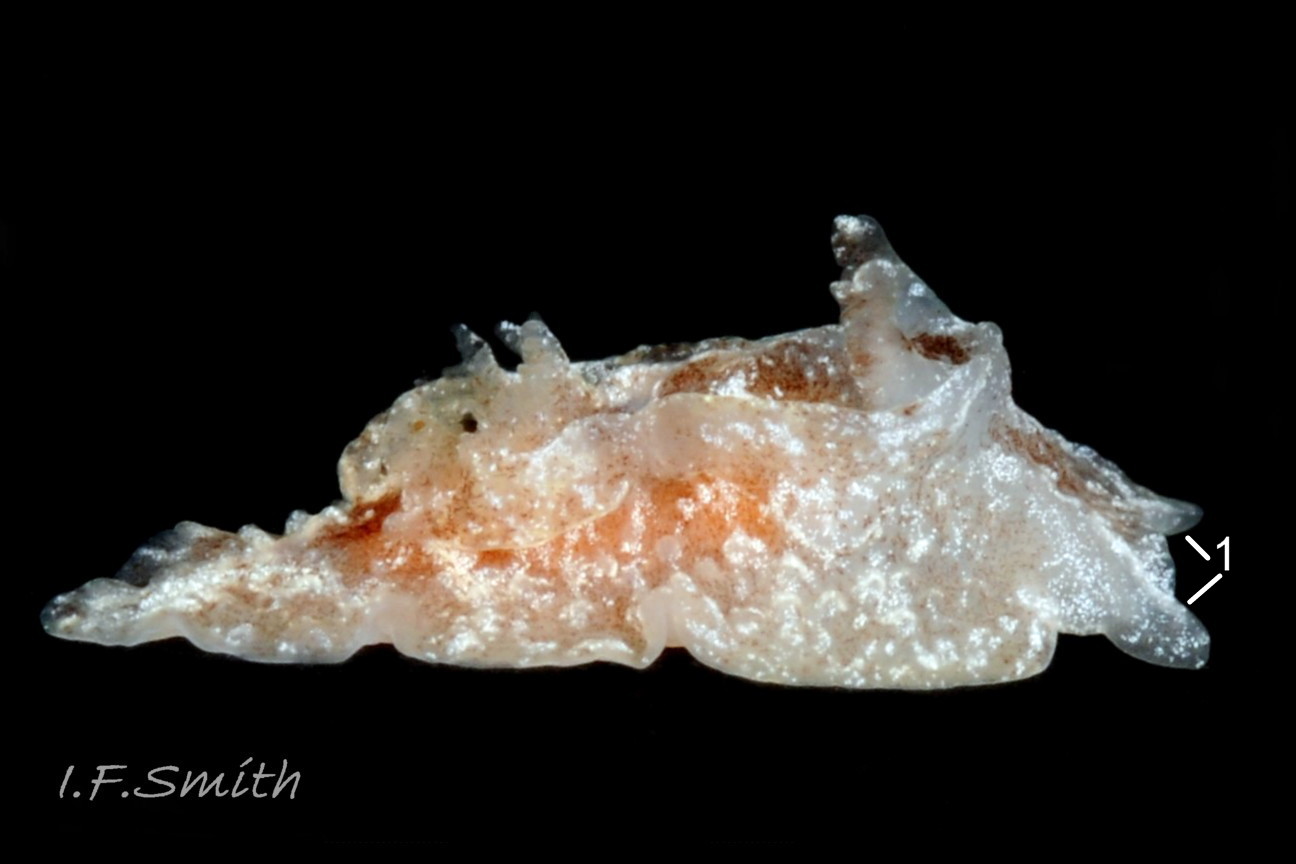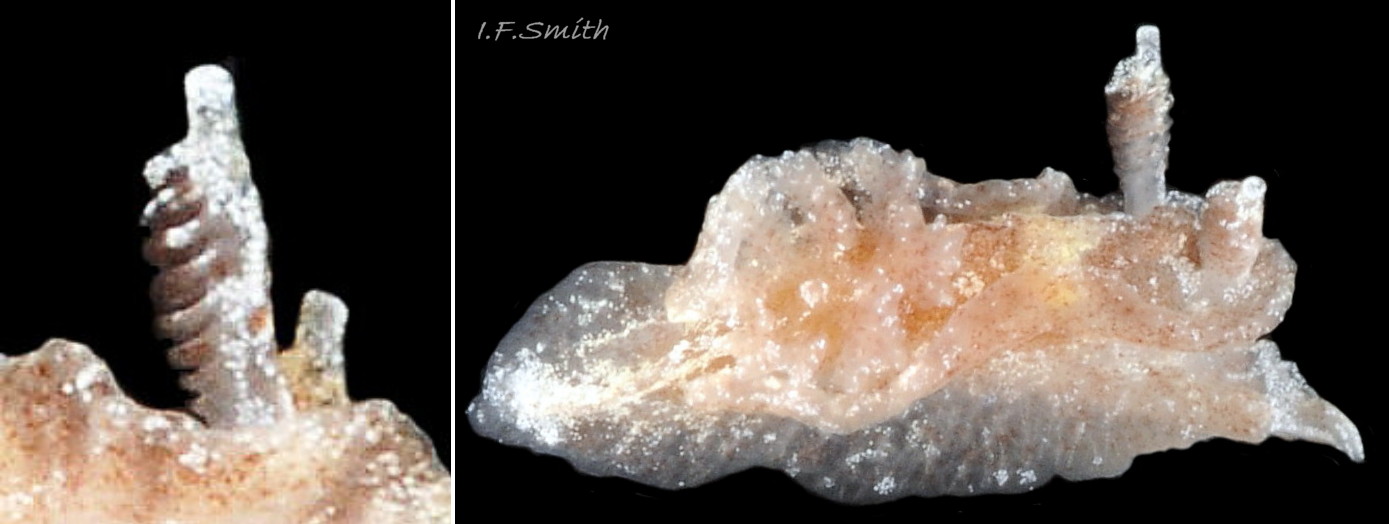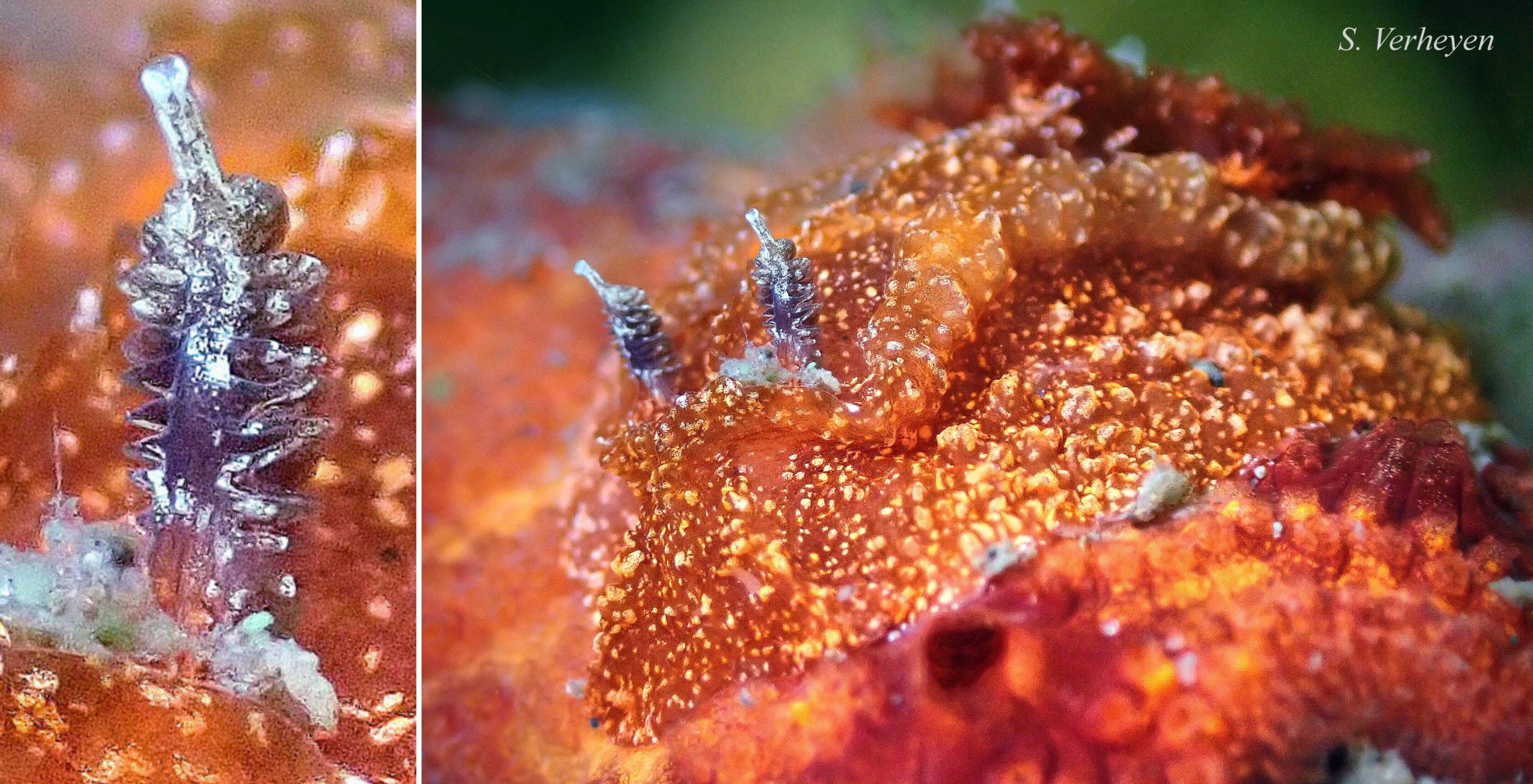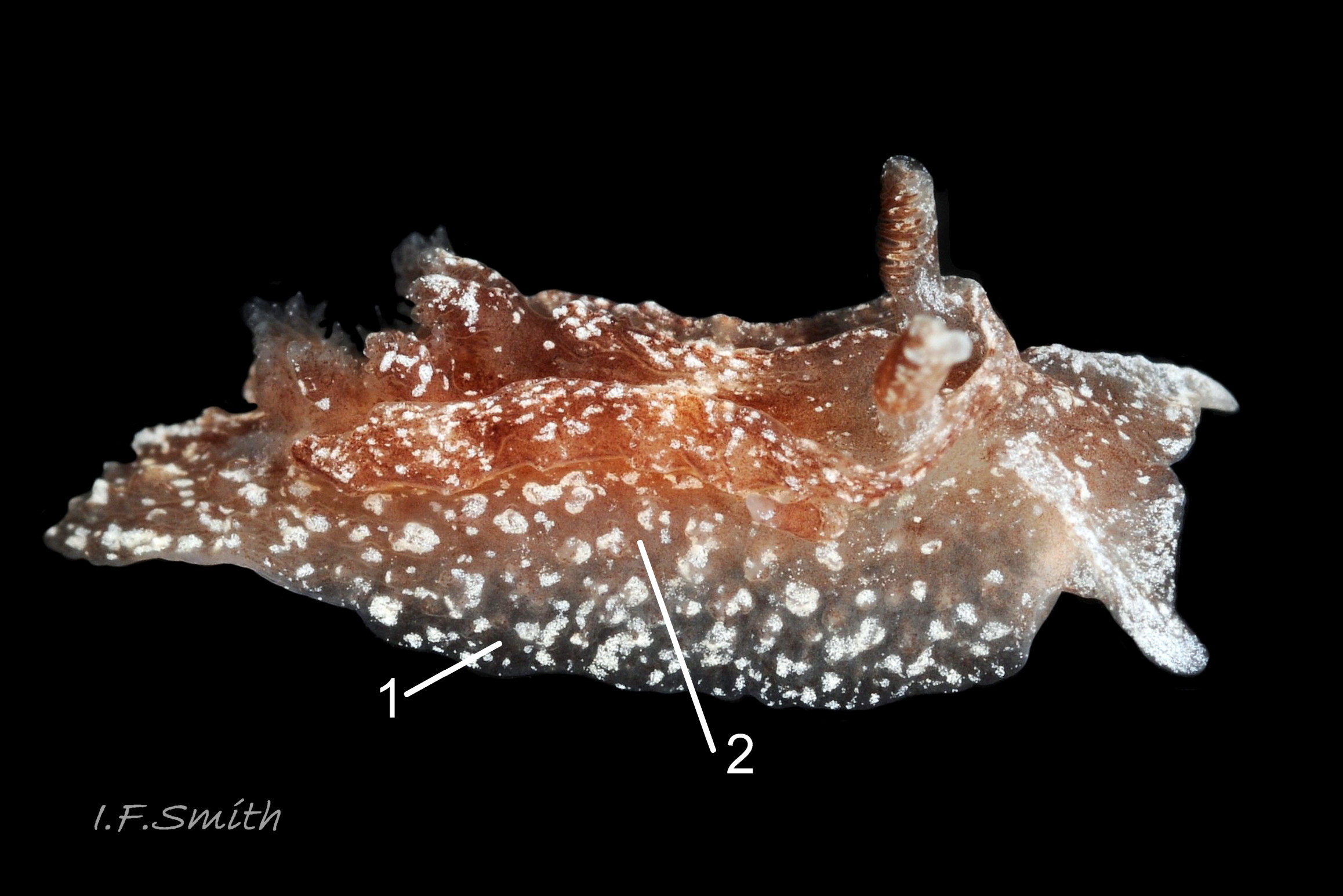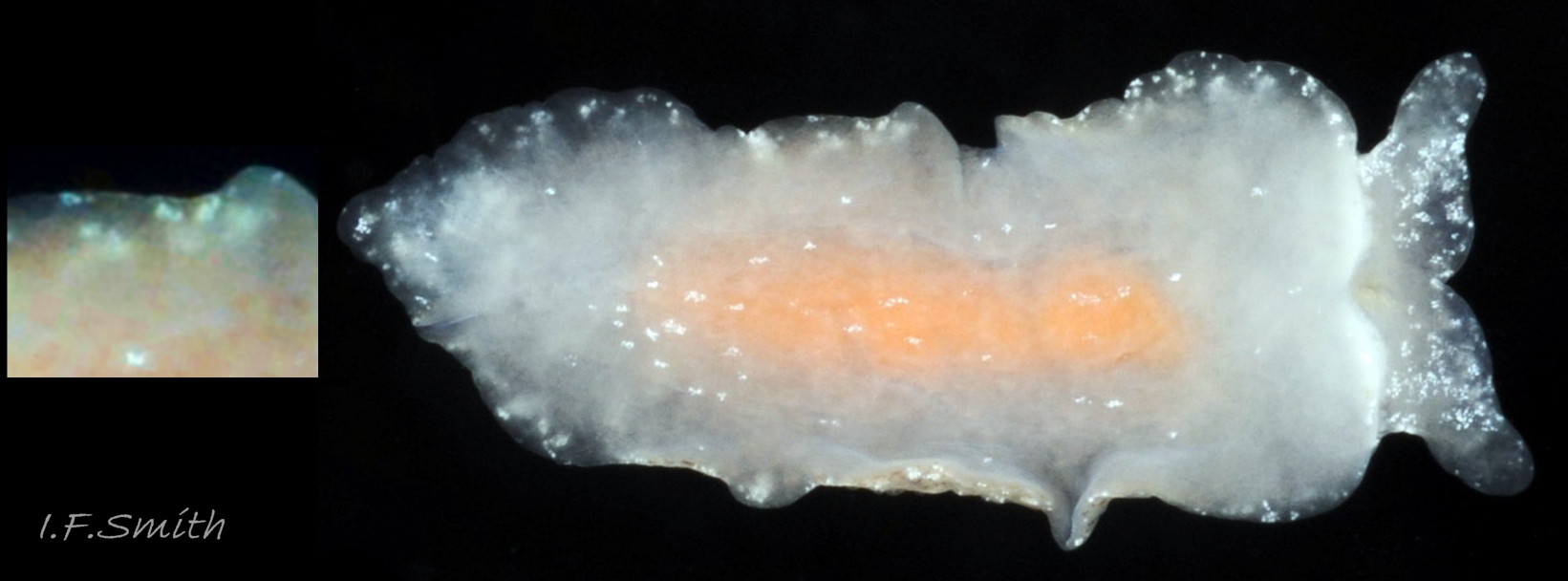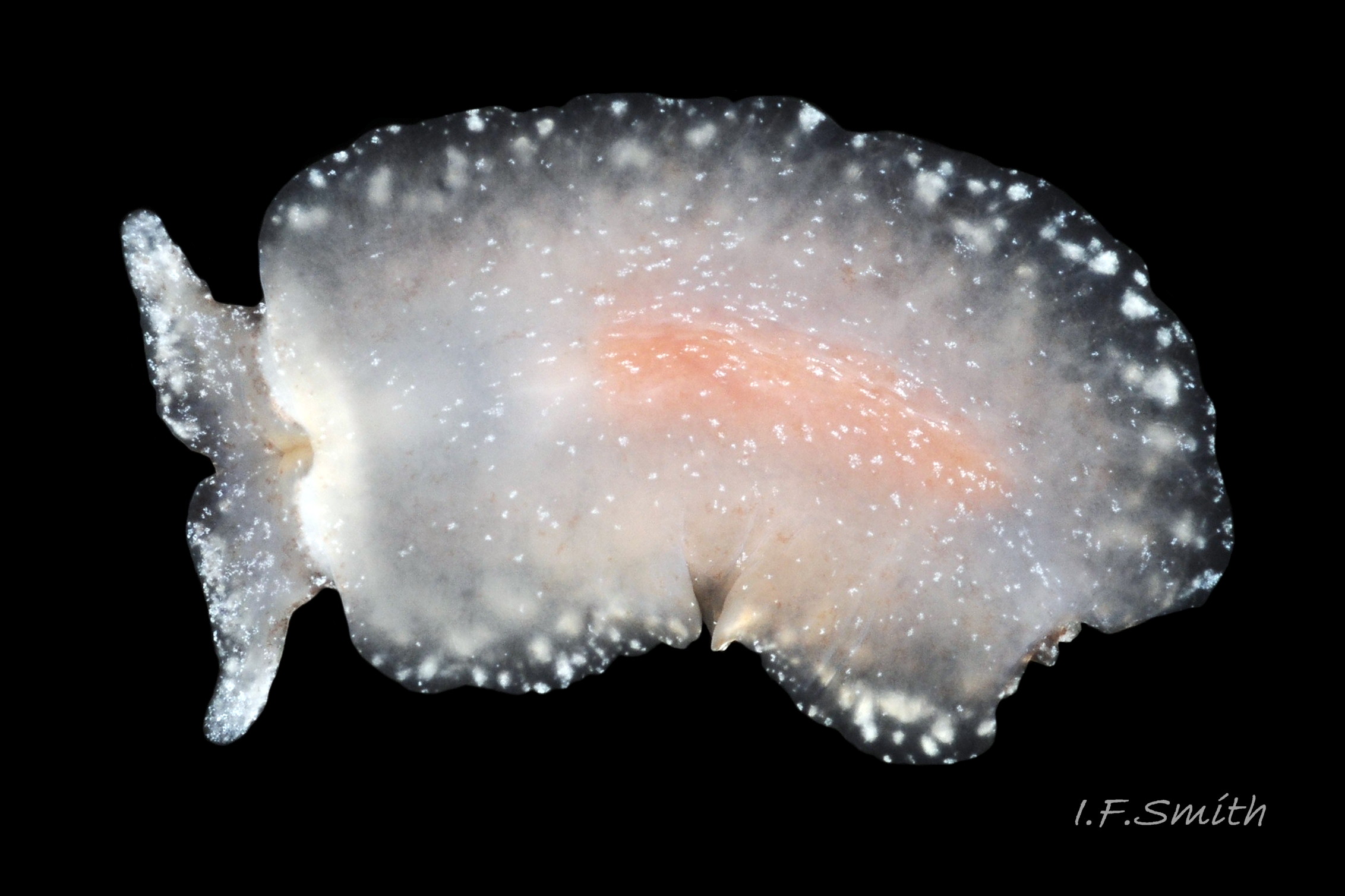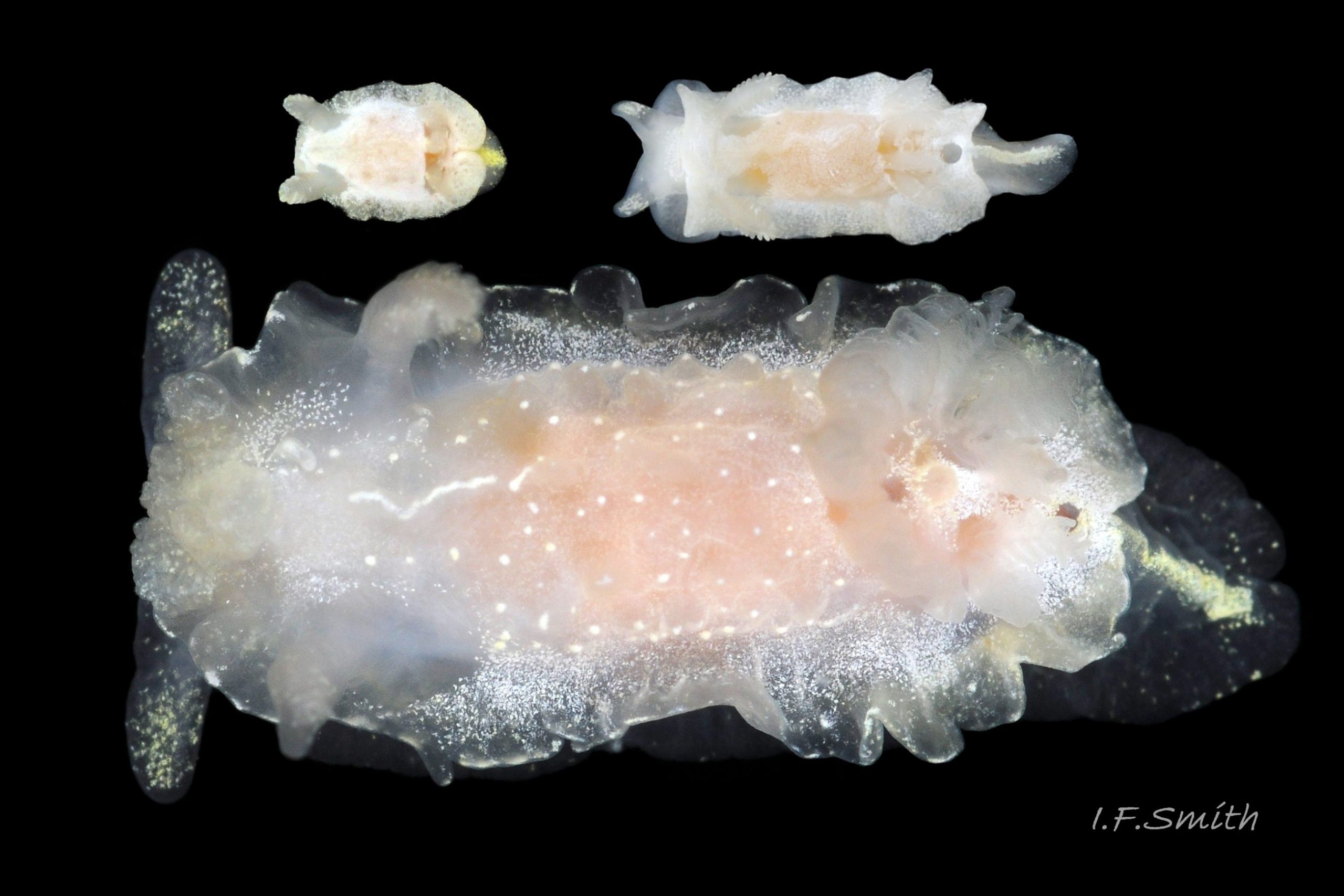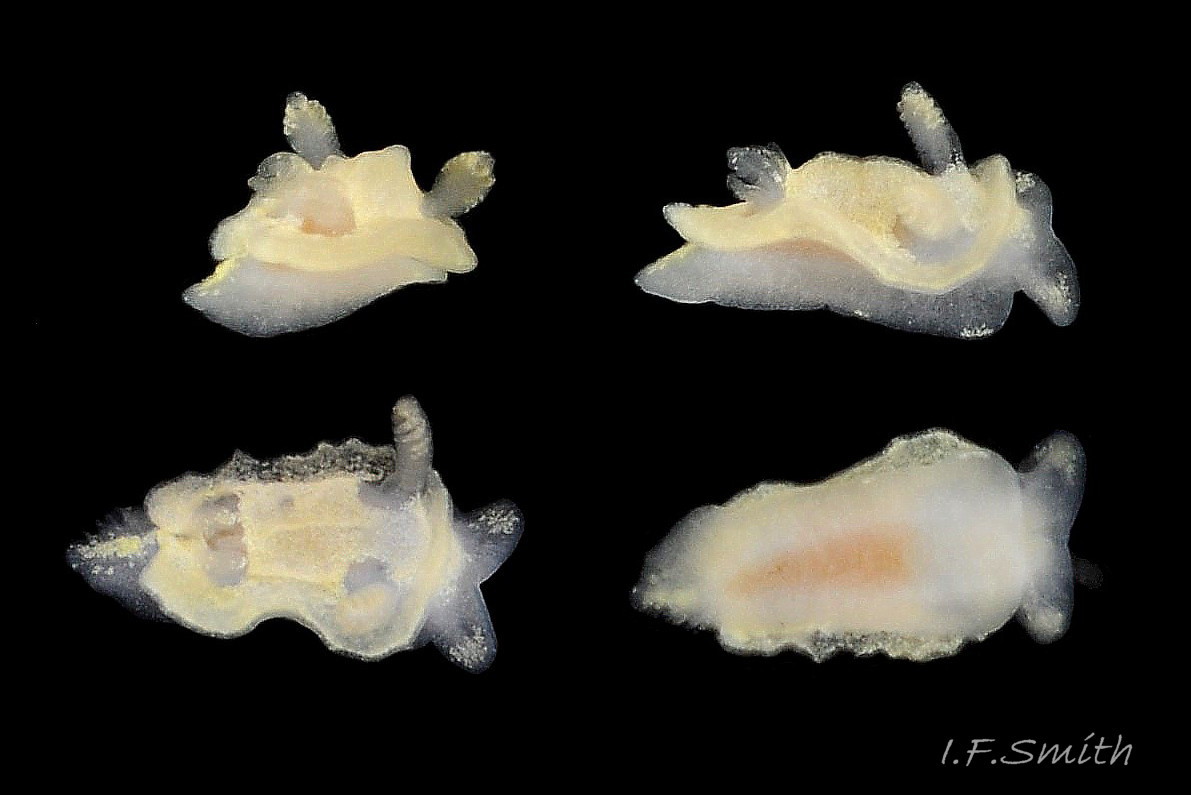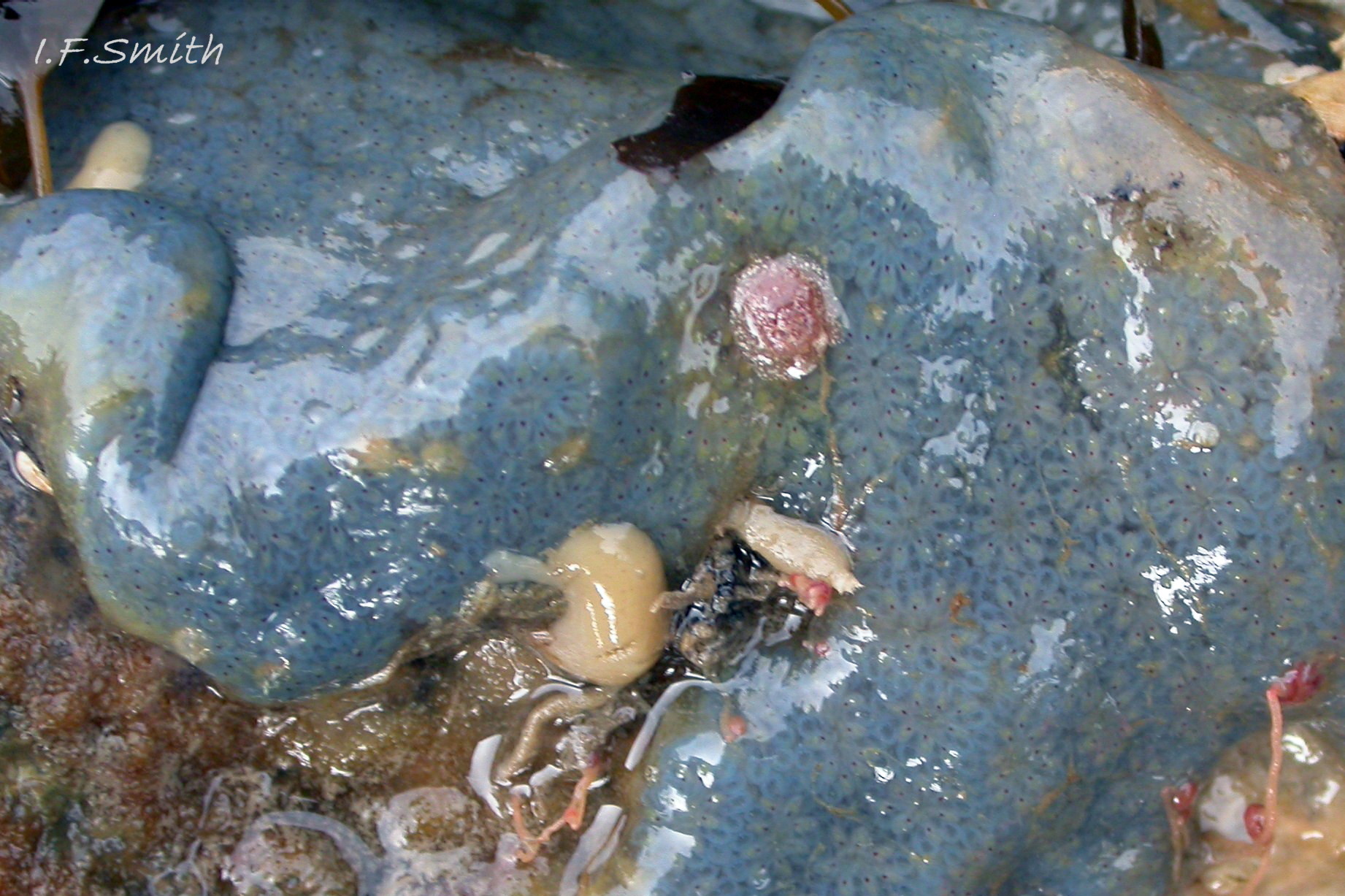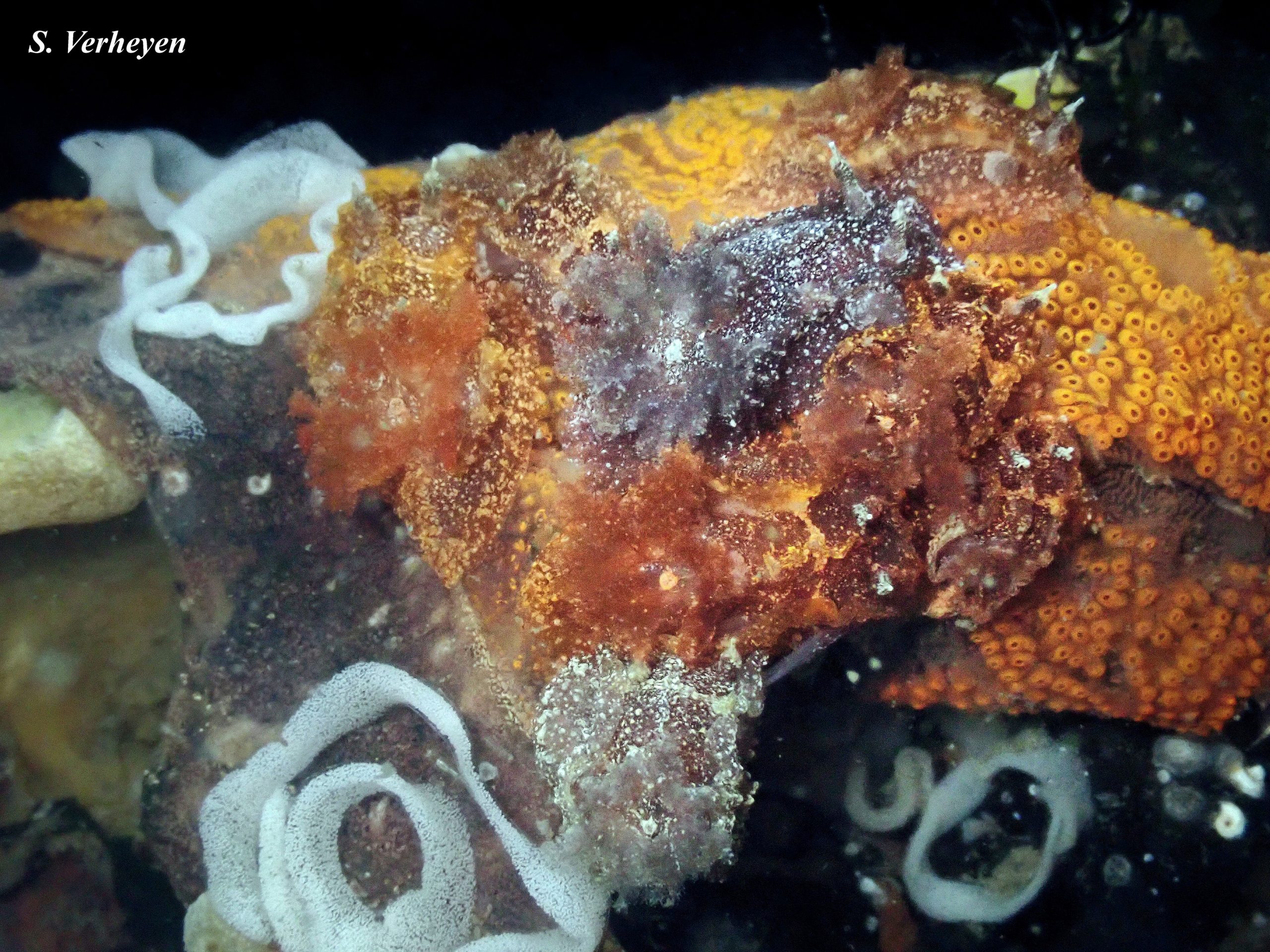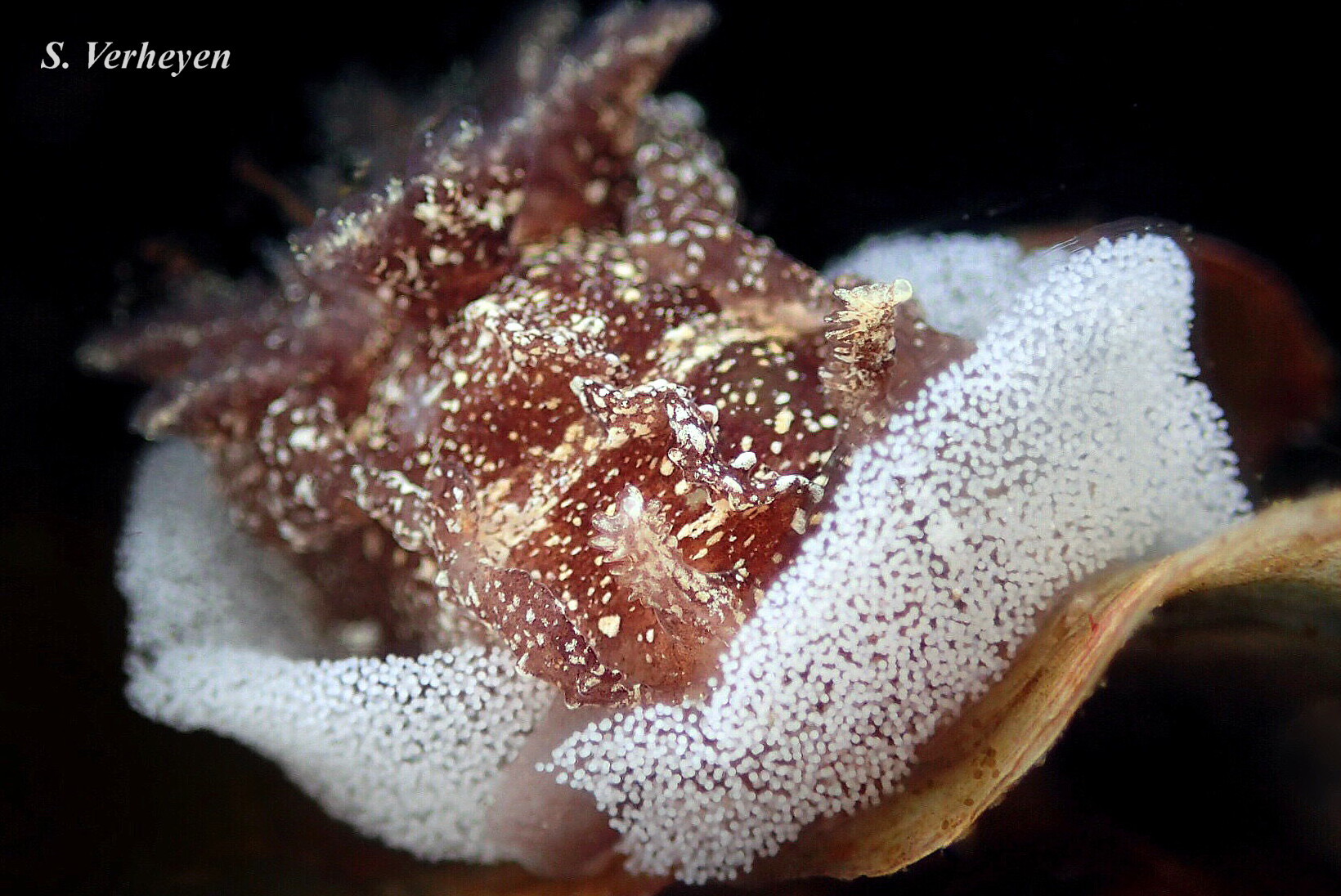Click image to enlarge with full caption. Main text below slider.
Goniodoris castanea Alder and Hancock, 1845
Authors: Ian F. Smith (text) and Stefan Verheyen (fieldwork and photography).
PDF available at www.researchgate.net/publication/356911758_Goniodoris_cas…
Current taxonomy: World Register of Marine Species www.marinespecies.org/aphia.php?p=taxdetails&id=140032
Synonyms: Doris pareti Vérany, 1846; Goniodoris brunnea Macnae, 1958.
GLOSSARY BELOW
Description
The body grows up to 38 mm long (Thompson & Brown, 1984). The mantle covers less than half of the body 01 Goniodoris castanea . It has a substantial medial, dorsal ridge 02 Goniodoris castanea with offshoots, and a prominent, fixed, erect rim stretching forwards from the gills and across the head 03 Goniodoris castanea & 04 Goniodoris castanea . The mantle is often chestnut brown, but it varies in intensity, especially in the Oosterschelde, Nederland, to include purple-black 05 Goniodoris castanea , purple-brown 06 Goniodoris castanea, brilliant red with gold 07 Goniodoris castanea and pinkish white 08 Goniodoris castanea . The rest of the dorsal body surface beyond the mantle is usually similar in colour but more translucent. The whole dorsal surface bears flecks of white or, occasionally, yellow 07 Goniodoris castanea , pigment, which can be small and relatively sparse 06 Goniodoris castanea or large and densely spread 09 Goniodoris castanea . Juveniles usually have paler, less intense colour 10 Goniodoris castanea & fig 19 19 Goniodoris castanea than adults. The whole of the dorsal surface is covered with translucent tubercles 03 Goniodoris castanea , 11 Goniodoris castanea & 12 Goniodoris castanea , which are difficult to discern among the pigment flecks unless they neatly coincide with the flecks 13 Goniodoris castanea & 07 Goniodoris castanea .
The large, when fully expanded, dorsal gills 01 Goniodoris castanea are thickset basally so the tripinnate structure is often only discernible distally 13 Goniodoris castanea , 4 14 Goniodoris castanea & 31 Goniodoris castanea . Up to nine are arranged in a circle with a small gap at the rear and the cylindrical anal papilla at the centre fig 15 15 Goniodoris castanea . The gills are usually coloured as the rest of the body, but sometimes with a darker or lighter shade, and juveniles may have transparent colourless gills 10 Goniodoris castanea . The hermaphrodite genital opening is to the rear of the right rhinophore on a slightly tapered, cylindrical, brown papilla, often with the tip of the penis showing 16 Goniodoris castanea . When mating, the translucent white penis, with fine brown marks basally, can extend to half the length of its body to reach the aperture of a mate 02 Goniodoris castanea .
The head has over the mouth an oral veil 17 Goniodoris castanea which extends into a pair of anterolateral oral tentacles reinforced with a strong longitudinal ridge on each 04 Goniodoris castanea & 18 Goniodoris castanea . The anterior edge of the veil has a deep, medial notch 17 Goniodoris castanea which, with the curvature of the tentacles, often gives it a shallow S-shape on each side. The rhinophores each have up to seventeen lamellae (Thompson & Brown, 1984) on the posterior, leaving the anterior face smooth fig 19 19 Goniodoris castanea . The smooth digitiform apex is offset to the anterior of the rhinophore. The rhinophores are translucent white 12 Goniodoris castanea and on adults they usually have much dark brown or purple brown with white pigment fig 19 19 Goniodoris castanea , even when the body is a contrasting colour 08 Goniodoris castanea & 20 Goniodoris castanea .
The upper surface of the foot is an uninterrupted continuation of the dorsal surface of the body not covered by the mantle, but it is more translucent 21 Goniodoris castanea especially on weakly pigmented, young specimens fig 19 19 Goniodoris castanea . The metapodium has a medial dorsal ridge 03 Goniodoris castanea . The sole is translucent white with opaque white and very faint brown pigment marks 22 Goniodoris castanea . It reveals salmon-pink to purple viscera centrally 23 Goniodoris castanea . It is broad at the anterior, sometimes tapering laterally to a posterior point 22 Goniodoris castanea and sometimes with almost parallel lateral edges until posterior of the mantle and gills where it tapers to a posterior point 23 Goniodoris castanea . The anterior edge has rounded corners with no propodial extensions, and it is deeply notched below the mouth 17 Goniodoris castanea .
Key identification features
G. castanea
1: Body chestnut brown, varying to pinkish white and dark purple with opaque white or, occasionally, yellow flecks 05 Goniodoris castanea .
2: Mantle with erect fixed edge does not cover sides of body 04 Goniodoris castanea .
3: Ridge on the oral tentacles 04 Goniodoris castanea & 18 Goniodoris castanea .
4: Oral tentacles are lateral extensions of an oral veil 17 Goniodoris castanea .
Similar species
G. nodosa (Montagu, 1808)
1: Body translucent white with opaque white, and sometimes yellow, flecks 24 Goniodoris castanea . No other colours apart from pinkish or yellowish viscera visible through translucent body. Usually a yellow or white medial band on the metapodium. Juveniles sometimes covered in powdering of yellow 25 Goniodoris castanea.
2: Mantle is more extensive than on G. castanea but usually leaves part of the body exposed 26 Goniodoris castanea though it can extend/move position to cover most of the body. Its edge is often flexed into undulations and does not stand upright in a fixed position.
3: No ridge on the oral tentacles.
4: Oral tentacles attached to the head; only a slight oral veil ( 27 Goniodoris castanea
Habits and ecology
G. castanea lives on hard substrate sublittorally to 25 m, and at ELWS on rocky shores. It feeds on ascidians, including Botryllus schlosseri 28 Goniodoris castanea , B. leachi, Dendrodoa sp. and Ascidia mentula. In the Oosterschelde, Nederland, it is very common in a wide range of colours feeding on the alien Botrylloides violaceus. The colours of G. castanea very often provide good camouflage on the different colour forms of its prey 29 Goniodoris castanea , 20 Goniodoris castanea & 08 Goniodoris castanea . It is most easily found when on a non-matching colour form, even when recessed in a pit eaten into its prey 28 Goniodoris castanea .
G. castanea is a simultaneous hermaphrodite, though penetration by the extended penes may not be simultaneous 02 Goniodoris castanea . The usual mating position of a pair is head to tail with the genital apertures on their right sides closely proximate 4 14 Goniodoris castanea so the extended penes may be hidden from view. Spawn 30 Goniodoris castanea has been recorded in Britain from February to October on or near its prey 29 Goniodoris castanea on or under stones or other hard surfaces in a spiral ribbon attached by one edge 31 Goniodoris castanea . After 12 or 13 days at 16° C, veliger larvae hatch from the spawn and drift as plankton before settling on the sea floor and transforming into adults (Thompson & Brown, 1984).
Distribution and status
G. castanea occurs from southern Norway into the Mediterranean; GBIF map www.gbif.org/species/2291986 . In 1984, Thompson and Brown stated it was widespread but never very common in any individual locality and, in the British Isles, had scattered records from all regions except western Ireland. Infrequent examples were reported from the Dutch coast (Swennen, 1961 in Thompson & Brown 1984). It seems to have had a large increase in its population in the Twenty-first Century as it is now frequently found by divers, and I have found it on shores of the Menai Strait, while I never found any in the 1970s in Orkney. It is now especially common sublittorally in the Oosterschelde estuary, Nederland. The apparent increase in population may be a direct result of climate warming, or indirectly by the large availability of invasive species of ascidian suitable for food, such as Botrylloides species, which are probably a result of accidental introduction and/or climate warming. The UK map at species.nbnatlas.org/species/NBNSYS0000175524 suggests that G. castanea is scarce or absent in the north-eastern Irish Sea and in the North Sea from Flamborough Head to Kent, despite its frequency in the Oosterschelde on the facing Dutch coast.
Acknowledgements
I gratefully thank Rokus Groeneveld ( www.diverosa.com/ ) for use of his images, and my co-author, Stefan Verheyen, for his numerous sublittoral images of the species in the Oosterschelde, Nederland. I thank Sarah Bowen and David Kipling for much appreciated advice about ascidian identifications.
References & links
Alder, J. & Hancock, A. 1845. Notice of a new genus and several new species of Nudibranchiate Mollusca. The annals and magazine of natural history; zoology, botany, and geology.16: 311- 316. Article: XXXIV
p. 314 www.biodiversitylibrary.org/page/22069384#page/328/mode/1up
Alder, J. & Hancock, A. 1845-1855. A monograph of the British nudibranchiate mollusca. London, Ray Society. www.biodiversitylibrary.org/item/131598#page/176/mode/1up
Groeneveld, R. & Reijs, S. Dutch Sea slugs www.diverosa.com/
Picton, B.E. & Morrow, C.C. 2010. Encyclopedia of Marine Life of Britain and Ireland.
www.habitas.org.uk/marinelife/species.asp?item=ZD2090 (includes ascidian prey species).
Thompson, T.E. & Brown, G.H. 1984. Biology of opisthobranch molluscs 2. London, Ray Society.
Current taxonomy: World Register of Marine Species www.marinespecies.org/aphia.php?p=taxdetails&id=140032
GLOSSARY
anterolateral = situated in front and to the side of.
digitiform = shaped like a finger.
distal = away from centre of body or from point of attachment.
ELWS = extreme low water spring tide (usually near equinoxes).
hermaphrodite, simultaneous = individual has both male and female features able to function at the same time with similar partner.
lamellae = small plates on rhinophores.
LWS = low water spring tide, two periods of a few days each month when tide falls lowest.
mantle = (of nudibranchs) sheet of tissue forming part or all of dorsal body surface.
medial = midline of body or organ.
metapodium = hind part of the foot.
oral tentacles = pair of tentacles on or near edge of mouth.
oral veil = anterior extension of head into a flat sheet, sometimes with lateral extensions to form tentacles.
papilla = (pl. papillae) small, nipplelike, sensory protruberance.
penes = plural of ‘penis’.
plankton = animals and plants that drift in pelagic zone (main body of water).
propodial = at the front of the foot.
rhinophore = chemo-receptor tentacle; many sea slugs have a pair on top of the head.
tripinnate = (of gill plume) threefold branching; “boughs, branches, twigs”.
veliger = shelled larva of marine gastropod or bivalve mollusc which moves by action of cilia on a velum (bilobed flap). Stage may be passed in plankton or within liquid-filled egg-capsule.
